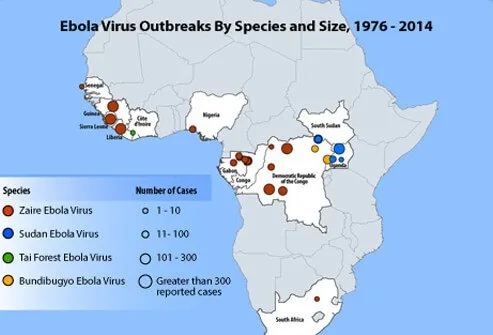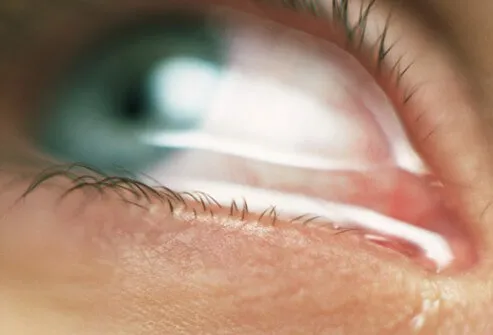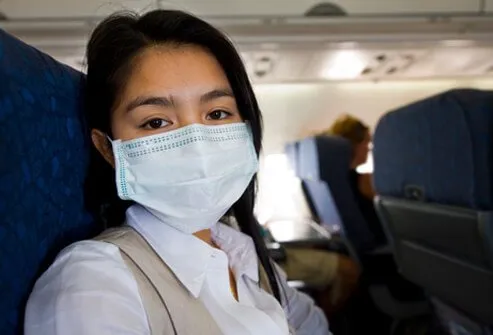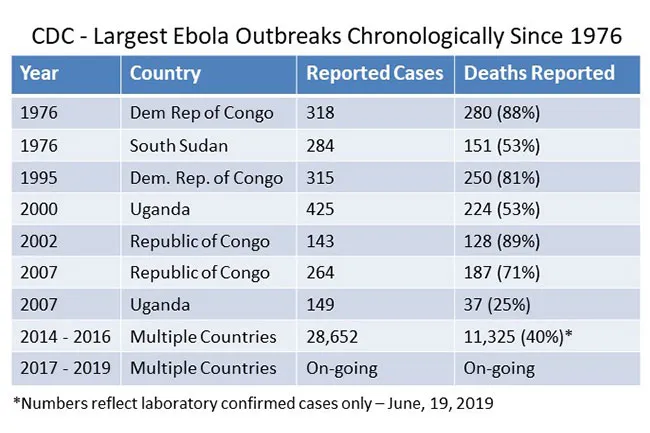What Is Ebola Virus?

Ebola is a viral hemorrhagic (bleeding) illness that has a high fatality rate. The virus was discovered in 1976 near the Ebola River in the present-day Democratic Republic of Congo. There are five strains of the Ebola virus -- Tai Forest, Sudan, Bundibugyo, Zaire, and Reston. Four of the strains (Reston is the exception) are responsible for outbreaks in humans. The Ebola virus is harbored by fruit bats, gorillas, monkeys, forest antelope, chimpanzees, and porcupines. Humans can contract the virus by coming into close contact with the body or bodily fluids (including blood) of an infected animal. Once the virus spreads to a human, person-to-person transmission is possible.
Ebola Outbreaks

Since 1976, outbreaks have occurred sporadically in Zaire, Sudan, Democratic Republic of Congo, Gabon, and Uganda. The largest outbreak by far began in March 2014 and lasted into April 2016. It affected Guinea, Liberia, Sierra Leone, Senegal, and Nigeria. This West Africa Ebola outbreak resulted in 28,652 reported cases and 11,325 deaths. Visit the Centers for Disease Control (CDC) website for the latest outbreak statistics.
How Is Ebola Transmitted?

In between human outbreaks, Ebola is believed to be harbored in animals that act as a “reservoir” for the virus. When a human contracts Ebola by handling an infected animal, person-to-person transmission can then lead to an outbreak. Ebola can be transmitted directly or indirectly. Direct transmission refers to the virus passing from an infected person to another person via sexual contact or by infected body fluids (blood, tears, feces, urine, vomit, for example) through contact with mucous membranes or broken skin. Indirect transmission refers to a person picking up a virus from a contaminated object, such as infected surgical equipment or a needle.
What Are the Signs and Symptoms of Ebola?

The signs and symptoms of Ebola virus are divided into two stages. First comes the "dry" phase, which varies from person to person. It frequently includes fever greater than 101°F, intense weakness, severe headache, joint/muscle pain, and sore throat. It may also include vomiting, diarrhea, abdominal pain, rash, and internal bleeding.
Some people with the illness go on to develop symptoms associated with the "wet" phase. These include bleeding from the eyes, nose, ears, and rectum. Lab tests may reveal abnormal liver and kidney function. Levels of white blood cells and platelets may be elevated. The incubation period of Ebola, defined as the period of time from exposure to the virus until the onset of symptoms, is 21 days. The average time from exposure to symptom development is about 8 – 10 days; bleeding is usually a later symptom that signifies severe infection.
Is Ebola Airborne?

In lab conditions, the Ebola virus has been shown to spread through the air. However, in real-world living conditions and in hospital settings, there is no evidence that Ebola can be transmitted through the air. While there are fears that Ebola could mutate and become more easily transmissible, the director of the CDC, Dr. Tom Frieden, stated that there has been little change in the Ebola virus in the past 40 years. He also said that there is no evidence that Ebola has undergone any changes that would make it easier to spread from person to person.
What Is the Fatality Rate of Ebola?

Every Ebola outbreak is different. Historically, the larger Ebola outbreaks have had a fatality rate of 25% to almost 90%. The Democratic Republic of the Congo Ministry of Health reports that the DRC outbreak has shown a 67% fatality rate from Aug. 2018 to Sept. 2019.
Is There Any Treatment for Ebola?

There is no cure for Ebola. New therapies are being investigated. Treatment for Ebola consists of supportive care which often includes administering intravenous (IV) fluids and monitoring and maintaining appropriate electrolyte, oxygen, and blood pressure levels. Prevention and treatment of other infections that may develop in the Ebola-infected patient is important as well.
Is There an Ebola Vaccine?

More than two decades in the making, a vaccine for Ebola was approved in Europe in late 2019. While now approved in Europe, the Ebola vaccine known as Ervebo has been approved by the US FDA in December of 2019. Vaccines to stop the spread of Ebola have already been administered three times in Africa, according to the World Health Organization, starting in 2015 when more than 16,000 volunteers were vaccinated. They were used again in May-July 2016 in Equateur Province, and again in the eastern region of Kivu in the Democratic Republic of the Congo in 2018-19.
Another investigational vaccine is expected to be used in 2019 for the DRC outbreak. This vaccine requires a second booster 56 days after the first dose, and is designed to work against the Zaire ebolavirus type.
Other Potential Treatments for Ebola

Although none have been approved by the FDA yet, four Ebola treatments have been attempted during the 2018 DRC outbreak on an investigational basis. These are ZMapp, REGN-EB3, mAb114, and remdesivir. The trial of two of the experimental drugs was halted early when the other two showed greater survival rates in Ebola patients. REGN-EB3 and mAb114 therapy made survival rates “much higher” according to the CDC.
Although their investigational trials ended early, both ZMapp, an antibody cocktail experimental therapy for Ebola, and remdesivir have been proven effective in the laboratory in summer 2019. These drug therapies were successful in 2014 during the West Africa Ebola outbreak. The ZMapp therapy consists of three monoclonal antibodies that are designed to treat existing Ebola infection. Monoclonal antibodies work by binding to proteins in the virus and “targeting” them for destruction by the immune system. Research continues into these therapeutic approaches.
Some drugs may be more effective in outbreaks with different strains of Ebola. These are difficult drugs to develop because Ebola virus is an RNA virus, and as such it is always mutating, according to the CDC.
Can Ebola Be Prevented?

Ebola virus infection has never taken place in the United States, according to the CDC. The only people with Ebola infection in the US acquired the disease elsewhere or got the infection from someone who entered the country already infected like two US caregivers.
People in areas known to have cases of Ebola can take the following precautions to minimize the risk of contracting the virus. Meticulous hygiene is necessary. Avoid people and bodily fluids of those known or suspected of having Ebola. Do not have contact with bats and wild animals; do not consume raw or undercooked animals that may have the virus. Only highly specialized, trained professionals with adequate protective gear should administer medical care to Ebola patients and handle the dead bodies of Ebola victims. Should you need medical care while you are in an area known to harbor Ebola, contact your embassy or consulate for a referral for an appropriate facility.
Ebola Virus: Outbreaks, Epidemics, and Symptoms
This tool does not provide medical advice. See additional information: 
© 1996-2024 WebMD, LLC. All rights reserved.
